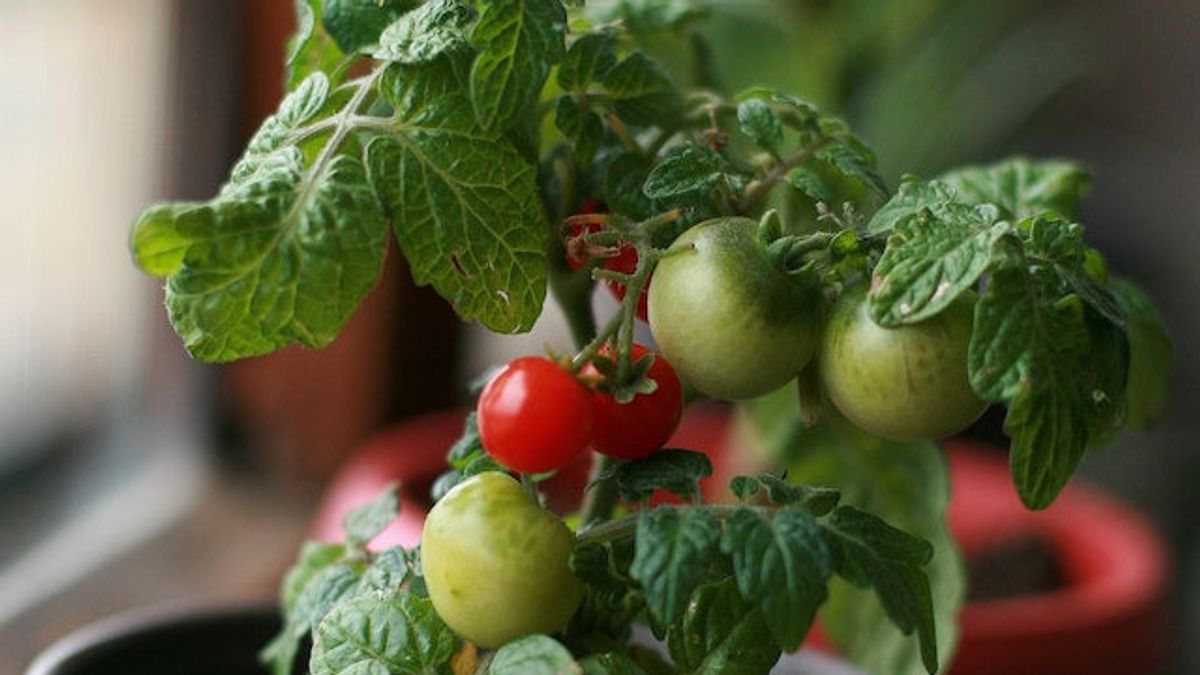JAKARTA - Ported leaves on tomatoes can be caused by many things such as environmental pressure, exposure to chemicals, to biological factors. Although this does not immediately make your plant die, determining the cause as early as possible is very important. The reason is, curved leaves are a stage of the process of stopping plant growth. So that the sooner you take action, the better.
Here are five causes of curved tomato leaves, reported by The Spruce, Friday, August 18.
Planting tomatoes when the weather is still cold can cause arches on the leaves. Usually it starts with the lower leaves curved upwards, then rolls long into. The leaves also become thick and rough but usually remain green.
As a precaution, make sure to grow tomatoes during the day with warm temperatures, around 22-30 celsius or at night with temperatures below 16-18 celsius.
In very hot, dry, or windy weather, tomato leaves twist and curl upwards to protect yourself from losing more water. If you live in a hot or hot climate, plant tomatoes in a location protected from strong and dry winds, then let the plants get sunlight in the afternoon.
Regardless of climate, always water the plants well. Once outdoors, tomato plants need at least 1 inch of water every week from rainfall or watering. Watering should be done slowly and deeply, so that plants form deep roots. Place the mulsa around the plant, so that the soil remains humid evenly.
Excessively fertilized tomatoes with nitrogen can see the leaves curling upwards which are thicker and greener than usual. Another sign, more leaf growth than fruit.
Fertilizer must be done in balance. After planting in nutritious soil properly, the tomato plant benefits from providing balanced 5-10-5 NPK fertilizer several times throughout the planting season. Avoid high nitrogen fertilizer (first number), or you will have lots of bright green leaves and fewer tomatoes.
Tomato plants are susceptible to herbisides. If the tomatoes leaf is curved downwards and grows transversally, it could be a plant exposed to herbisides. It could be from neighbors who care for grass or agricultural fields in the area. Spray of glyphosat or 2.4-D, dimulated, and other hormone species of herbisides, can cause herbiside flows with wind speeds of five miles per hour
After the flow of herbirides occurs, nothing can be done. Depending on the severity of the damage caused by herbirides, plants can recover, and new growth may look normal. If new growth continues to show damage to herbirides, which in addition to rolling leaves, may include white bars and splitting and defective fruit, you need to replant your tomato plants.
VOIR éGALEMENT:
Two common viruses that cause tomato leaves to curl are the curved yellow tomatoes leaf virus and the mosaic tomato virus. The kebul plant transmits the yellow tomatoes leaf virus, the new leaves rise and turn pale green. The edges of the leaves turn yellow, and the bottom can turn purplish. All plant growth is hampered, and the fruit production is bad.
The mosaic virus of tomatoes is transmitted from seeds, grafting, human handling, and tobacco products. In addition to dredging, the leaves become crosses, new shoots are small and the fruit is attacked in brown on the inside.
To reduce the kebul fly on the leaves, use reflective mulch (aluminum or silver) between rows. To get rid of white flies, mix the oil spray solution 0.25 to 0.5 percent (2 to 4 tablespoons of horticultural or canola oil with several drops of dish washing soap per gallon of water) and spray on the leaves every week.
An important step to prevent your plant from being infected is to keep the garden free from weeds. Because weeds are often the host plant for insects that then transmit the virus to tomatoes plants.
The English, Chinese, Japanese, Arabic, and French versions are automatically generated by the AI. So there may still be inaccuracies in translating, please always see Indonesian as our main language. (system supported by DigitalSiber.id)


















